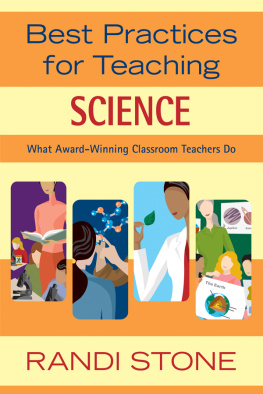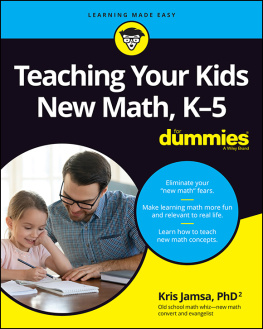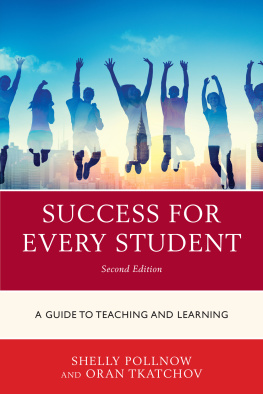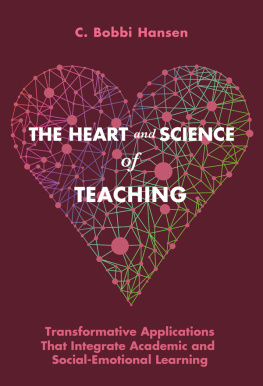Contents
Page-list
Guide

Advance Acclaim
Teaching to Every Kids Potential is not a dreaded flavor of the year educational reform. Instead, the approach in this book is to slightly tweak what we do every dayin the classroom, out on the playground, on the favorite end-of-the-year field tripto connect with and spark the fire of learning in each student. Layne Kalbfleisch has shared with us invaluable neuroscience research on learning, great insight about its practical application and, most importantly, the belief that all children can learn, and that we are capable of providing the enriched environment to enable all children to learn. This is a must-read for every student teacher, teacher, school administrator, and university education professor!
Vannetta R. Perry, Ed.D., Former Superintendent of Schools, Magdalena, New Mexico
The opening chapter of Teaching to Every Kids Potential contains a sentence which is both a statement of fact and a call to action: We havent yet achieved the rapport to really marry the fields of education and neuroscience. Written by someone who is both an accomplished cognitive neuroscientist and a seasoned hands-on educator, this book goes a long way toward accomplishing that rapport. In a concise and accessible manner, Layne Kalbfleisch places some of the central concepts of cognitive neuroscience in a direct educational context.
Elkhonon Goldberg, Ph.D., Director, Luria Neuroscience Institute, and Clinical Professor of Neurology, Grossman NYU School of Medicine
One of the greatest challenges facing scholars such as Dr. Kalbfleisch is to connect neuroscientific research and concepts to real world applications. This excellent book builds the bridge and points the way to future possibilities.
Jack A. Naglieri, Ph.D., Research Professor, University of Virginia, Emeritus Professor George Mason University and Senior Research Scientist, Devereux Center for Resilient Children
This is a remarkable book. It is an essay on what I imagine as an emerging double helix of education best practices and evolving neuroscience. The author, an educational psychologist, challenges many current educational sacred cows and offers creative, imaginative, emotionally-informed, and science-based alternatives. Kalbfleisch offers to educators of all types a vision of the world in which teachers and students are not inanimate stick figures or electronic data storage silos for uploading and downloading. Her four imperativesflexibility, readiness, connection, and (un)maskingprovide the cognitive/affective/relational architecture to help realize every kids potential (to which I add: and every teachers potential as well).
Howard F. Stein, Professor Emeritus in the Department of Family and Preventive Medicine, University of Oklahoma Health Sciences Center
Norton Books in Education
TEACHING TO EVERY KIDS POTENTIAL
Simple
NEUROSCIENCE
LESSONS to
Liberate Learners

LAYNE KALBFLEISCH

Note to Readers: This work is intended as a general information resource for teachers and school administrators. Models and/or techniques described are illustrative or are included for general informational purposes only. Neither the publisher nor the author can guarantee the efficacy or appropriateness of any particular recommendation in every circumstance. For case-specific questions and guidance, please consult with your school and/or community mental-health clinicians. The names of all students mentioned have been changed and identifying details changed or omitted. Any URLs displayed in this book link or refer to websites that existed as of press time. The publisher is not responsible for, and should not be deemed to endorse or recommend, any website other than its own or any content not created by it. The author, likewise, is not responsible for any third-party material.
Copyright 2021 by Layne Kalbfleisch
All rights reserved
First Edition
For information about permission to reproduce selections from this book, write to Permissions, W. W. Norton & Company, Inc., 500 Fifth Avenue, New York, NY 10110
For information about special discounts for bulk purchases, please contact W. W. Norton Special Sales at specialsales@wwnorton.com or 800-233-4830
Cover design by Lauren Graessle
Cover art Richard Drury/Getty Images
Production manager: Katelyn MacKenzie
The Library of Congress has cataloged the printed edition as follows:
Names: Kalbfleisch, M. Layne, author.
Title: Teaching to every kid's potential : simple neuroscience lessons to
liberate learners / Layne Kalbfleisch.
Description: First edition. | New York, NY ; London : W.W. Norton &
Company, 2021. | Series: Norton books in education | Includes
bibliographical references.
Identifiers: LCCN 2020047540 | ISBN 9780393713084 (paperback) | ISBN
9780393713091 (epub)
Subjects: LCSH: Individualized instruction. | Classroom environment. |
Cognitive neuroscience. | Academic achievement--Psychological aspects.
Classification: LCC LB1031 .K34 2021 | DDC 371.39/4--dc23
LC record available at https://lccn.loc.gov/2020047540
W. W. Norton & Company, Inc., 500 Fifth Avenue, New York, N.Y. 10110
www.wwnorton.com
W. W. Norton & Company Ltd., 15 Carlisle Street, London W1D 3BS
Contents
Bringing this book to maturity took three years, two editors, and one author! My gratitude goes to my editor, Carol Collins, and her team, Mariah Eppes and Jamie Vincent, for their patience, sharp eye for detail, and good cheer.
How do we teach so that knowledge transfers and how do we transfer knowledge between neuroscience and education about those processes so that we can teach and learn better? The four neurological imperatives you will encounter for learning, one in each chapter, are the result of a lot of thinking about that. I can see clearly the children and young adults whose learning opportunities will change for the better because were going to improve at recognizing them and learning with them. The children in my life, from my practice, and especially my grandchildren, nieces, and nephew, whose needs, curiosity about the world, talent, and thirst for knowledge, mirror back to me what you will encounter in this book.
Thank you to my students at Northern New Mexico College, and to young master Fermin, my consultant. Thank you to my husband, family, and dear friends who have lived with my activities and preoccupation in service of the book. I dedicate it to all of you and to current and future teachers and learners as we adapt to pandemic constraints and opportunities; thriving and learning anew. Thank you. Im so grateful. Miigwech.
Layne Kalbfleisch
December 14th, 2020
Everyone who remembers his own education remembers teachers, not the methods and techniques. The teacher is the heart of the educational system.
SIDNEY HOOK (UROFSKY, 2020)
E ducation needs some new behavioral policies that will bring instruction in line with our human neurology and support the inevitable and ever-present individual differences in how people learn. By behavioral policies I mean that there are certain assumptions made during teaching and learning that we now know are not in line with how we are neurologically wired. These are neurological imperatives emerging from cognitive neuroscience that suggest new directions for teaching and learning and how we school. This book is about the fruitful crossings and intersections materializing from the learning sciences today.














